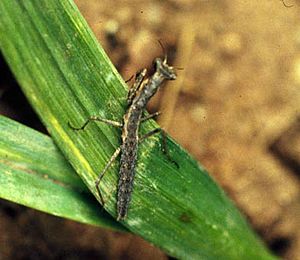Agile ground mantis facts for kids
Quick facts for kids Agile ground mantis |
|
|---|---|
 |
|
| Scientific classification |
The Litaneutria minor, also known as the agile ground mantis, is a cool insect. It lives in the dry parts of North America. You can find it in places like Colorado, Arizona, and California in the United States. It also lives in Mexico. In Canada, it's found in the southern Okanagan Valley. This mantis is special because it's Canada's only native mantis species. These mantises are very active hunters. You can often see them running across the ground. They are active from early spring until late summer.
Contents
About the Agile Ground Mantis
Both male and female agile ground mantises grow to be about 30 millimeters (about 1.2 inches) long. Adult mantises are usually dark grey or dark tan. Their front legs are special for catching food. They have four spines on the outer part of their front thigh. These spines help them hold onto their prey. Unlike many other mantises, their front thigh does not have a special groove. They also have long, thin antennae that look like threads.
Male mantises have 8 sections on their belly. They have a brown spot near the bottom of their front wings. Female mantises have 6 belly sections. Their upper back (pronotum) feels rough. Females do not have full wings, but they often have small wing pads. Males have much bigger wings than females. However, even with these wings, male agile ground mantises do not fly.
How They Live and Hunt
The agile ground mantis is often seen hunting on sunny days. They usually hunt on open ground. Sometimes, they hunt on small bushes just a few centimeters above the ground.
Like all mantises, the agile ground mantis has strong front legs. These legs are perfect for grabbing and holding prey. The spines on their front legs help them quickly close in on their food. They hold their prey tightly while they start to eat it.
Young mantises, called nymphs, can sometimes eat each other. This is common for many mantis species. Nymphs start hunting on their very first day. When they are young, they mostly eat small flies. As they grow bigger, they will hunt and attack almost anything they can catch.
Their usual food includes moths, flies, grasshoppers, katydids, and crickets. Unlike most praying mantises that "sit and wait" for food, agile ground mantises are different. They have been seen chasing after their prey!
Life Cycle of the Mantis
The agile ground mantis is a solitary animal. This means it lives alone most of the time. Like other praying mantises, they only come together to mate. When they mate depends a lot on the weather and how much food is available. Females are most ready to mate and lay eggs about two weeks after their last molt. A molt is when an insect sheds its old skin to grow.
About two weeks after mating, the female mantis lays her eggs. She puts them in a special egg case called an ootheca. She attaches the ootheca to twigs and branches. Each ootheca is about 5 to 10 millimeters (0.2 to 0.4 inches) long. It holds 10 to 20 eggs. The eggs stay safe in the ootheca all winter. If they survive, tiny nymphs will hatch in early spring.
Female mantises molt about 7 times as they grow. Their last molt happens in mid to late summer. Male mantises molt only 6 times. Their last molt also happens in mid to late summer. Young mantises spend all spring and early summer growing. They catch as much food as possible during this time.
Adult mantises become ready to mate in late summer. They will mate as soon as they are old enough. Females start laying eggs in late summer and early fall. They keep laying eggs until they and the males die during the fall months. Only the eggs that have been fertilized survive the winter. The next generation of mantises will hatch the following spring.
How They Defend Themselves
The Litaneutria minor uses its small size and dark color to stay safe from predators. Its dark color helps it blend in with small rocks, broken twigs, and dark plants. These are common in its home. Because it is small, it can quickly run and hide under rocks or thick plants.
The agile ground mantis is also very brave. It will defend itself against predators or even prey that tries to fight back. When it feels threatened, it will stretch its front legs out wide. It stands as tall as it can to try and scare away enemies.
Many mantises that can fly have a special ear. This ear can hear very high-pitched sounds, called ultrasonic frequencies. Bats use these sounds to find their way (this is called echolocation). If a flying mantis hears a bat, it can change its flight path. It will fly in random loops and twirls to try and escape the bat.
However, the agile ground mantis does not have this special ear. It can only hear best at lower frequencies. This is because it doesn't need to hear bats anymore. Why? Because it can't fly!
See also
 In Spanish: Litaneutria minor para niños
In Spanish: Litaneutria minor para niños

